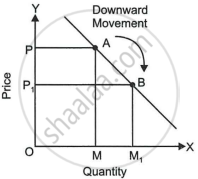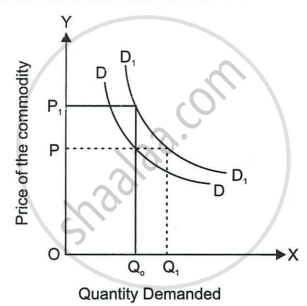Advertisements
Advertisements
Question
Differentiate between extension and contraction of demand.
Solution
| Basis | Extension of Demand | Contraction of Demand | ||||||||||||
| (i) Meaning | Other things being equal, when a fall in price raises demand for a commodity, it is called an extension of demand or increase in the quantity demanded. | Other things being the same, when demand for a commodity falls as a result of a rise in its price, it is called a contraction of demand or decrease in quantity demanded. | ||||||||||||
| (ii) Demand curve | Under it, there is a downward movement along the same demand curve (from A to B), as shown in Figure, but the consumer remains on the same demand curve.  |
Under it, there is upward movement along the same demand curve (from B to A as shown in Figure).  |
||||||||||||
| (iii) Example |
|
|
||||||||||||
| (iv) Cause | It is caused by a fall in the price of the commodity; other things remain the same. | It is caused by a rise in the price of the commodity only. |
APPEARS IN
RELATED QUESTIONS
If Coke and Fanta are close substitutes to each other, a rise in price of Coke will lead to ______ for Fanta.
What does a downward movement along the same demand curve indicate?
When the demand curve of a product shifts to the right, it represents a situation of ______.
What is an expansion of demand?
There are train and bus services between New Delhi and Jaipur. Suppose the train fare between the two cities comes down. How will this affect the demand curve for bus travel between the two cities?
With the help of a suitable diagram, distinguish between a change in quantity demanded and a change in demand.
What is meant by an increase in demand?
Explain the following diagram.

State whether the following statement is true or false. Give reasons.
A change in quantity demanded as a result of price change will imply a shift of the demand curve to the right.
State whether the following statement is true or false. Give reasons.
Contraction of demand is the result of a decrease in the number of consumers.
